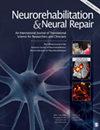Upper Extremity Contralaterally Controlled Functional Electrical Stimulation Versus Neuromuscular Electrical Stimulation in Post-Stroke Individuals: A Meta-Analysis of Randomized Controlled Trials
IF 3.7
2区 医学
Q1 CLINICAL NEUROLOGY
引用次数: 3
Abstract
Background Electrical stimulation has been employed as a safe and effective therapy for improving arm function after stroke. Contralaterally controlled functional electrical stimulation (CCFES) is a unique method that has progressed from application in small feasibility studies to implementation in several randomized controlled trials. However, no meta-analysis has been conducted to summarize its efficacy. Objective To summarize the effect size of CCFES through measures of upper extremity motor recovery compared with that of neuromuscular electrical stimulation (NMES). Methods The PubMed, Cochrane Library, EMBASE, Scopus, and Google Scholar databases were searched. Randomized controlled trials (RCTs) were selected and subjected to meta-analysis and risk of bias assessment. Results 6 RCTs were selected and 267 participants were included. The Upper Extremity Fugl-Meyer assessment (UEFMA) was included in all studies, the Box and Blocks test (BBT) and active range of motion (AROM) were included in 3 and 4 studies, respectively. The modified Barthel Index (mBI) and Arm Motor Abilities Test (AMAT) were included in 2 and 3 studies, respectively. The CCFES group demonstrated greater improvement than the NMES did in UEFMA (SMD = .42, 95% CI = .07–.76), BBT (SMD = .48, 95% CI = .10–.86), AROM (SMD = .54, 95% CI = .23–.86), and mBI (SMD = .54, 95% CI = .12–.97). However, the results for AMAT did not differ significantly (SMD = .34, 95% CI = −.03–.72). Conclusion Contralaterally controlled functional electrical stimulation produced greater improvements in upper extremity hemiplegia in people with stroke than NMES did. PROSPERO registration number: CRD42021245831中风后个体上肢对侧控制功能电刺激与神经肌肉电刺激:随机对照试验的荟萃分析
脑卒中后电刺激是一种安全有效的改善手臂功能的治疗方法。对侧控制功能电刺激(CCFES)是一种独特的方法,已经从小型可行性研究的应用发展到在几个随机对照试验中实施。然而,尚未进行meta分析来总结其疗效。目的比较CCFES与神经肌肉电刺激(NMES)对上肢运动恢复的影响。方法检索PubMed、Cochrane Library、EMBASE、Scopus、谷歌Scholar等数据库。选择随机对照试验(rct)进行meta分析和偏倚风险评估。结果共选择6项随机对照试验,纳入受试者267人。上肢Fugl-Meyer评估(UEFMA)被纳入所有研究,Box and Blocks test (BBT)和active range of motion (AROM)分别被纳入3项和4项研究。改良Barthel指数(mBI)和手臂运动能力测验(AMAT)分别被纳入2项和3项研究。CCFES组在UEFMA (SMD = 0.42, 95% CI = 0.07 - 0.76)、BBT (SMD = 0.48, 95% CI = 0.10 - 0.86)、AROM (SMD = 0.54, 95% CI = 0.23 - 0.86)和mBI (SMD = 0.54, 95% CI = 0.12 - 0.97)方面的改善优于NMES。然而,AMAT的结果没有显著差异(SMD = 0.34, 95% CI = - 0.03 - 0.72)。结论对侧控制功能性电刺激对脑卒中患者上肢偏瘫的改善效果优于NMES。普洛斯彼罗注册号:CRD42021245831
本文章由计算机程序翻译,如有差异,请以英文原文为准。
求助全文
约1分钟内获得全文
求助全文
来源期刊
CiteScore
8.30
自引率
4.80%
发文量
52
审稿时长
6-12 weeks
期刊介绍:
Neurorehabilitation & Neural Repair (NNR) offers innovative and reliable reports relevant to functional recovery from neural injury and long term neurologic care. The journal''s unique focus is evidence-based basic and clinical practice and research. NNR deals with the management and fundamental mechanisms of functional recovery from conditions such as stroke, multiple sclerosis, Alzheimer''s disease, brain and spinal cord injuries, and peripheral nerve injuries.

 求助内容:
求助内容: 应助结果提醒方式:
应助结果提醒方式:


